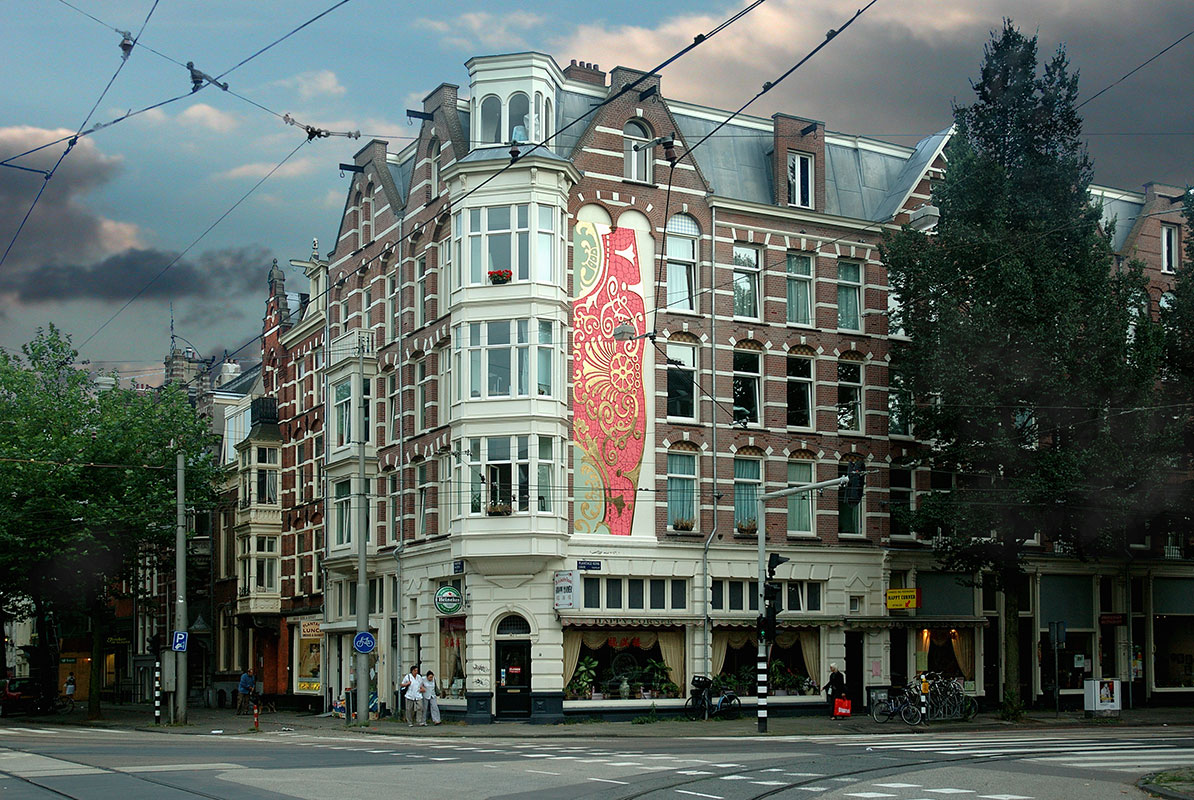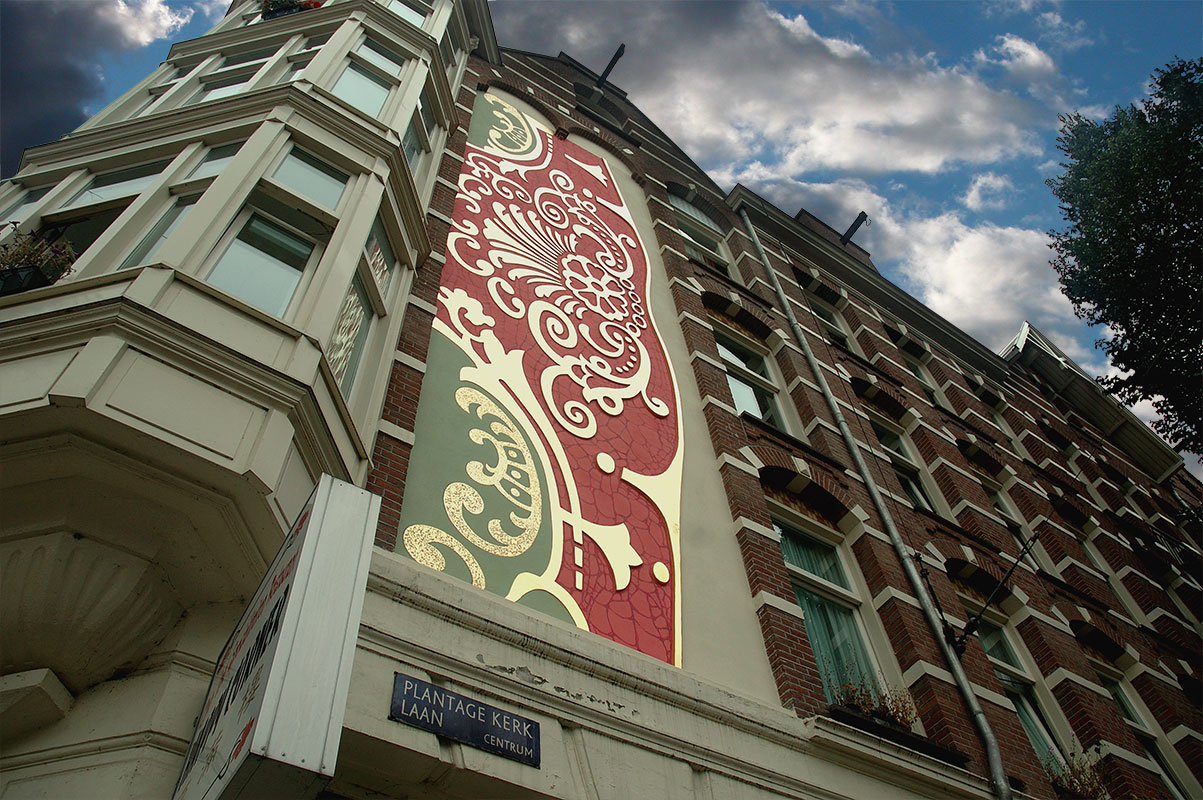FADING LACE


"Fading Lace", 2004. Plantage Kerklaan, Amsterdam, Netherlands. Courtesy: Ymere & AFK, Amsterdam, Netherlands.
HvD: You lived and studied in Amsterdam from 1997 until 2003. How do you look back on your Amsterdam years and more specifically on the commission from Ymere to make "Fading Lace"?
EO: I was invited as a participant to the Rijksakademie, in Amsterdam, for the years 1997-1998. This was after my architectural studies in Ankara. The Rijksakademie is a majestic institute for producing, publishing and promoting artistic research at both the artistic and intellectual levels, without discrimination with regard to the background of candidates. I happened to take part in two very important Dutch oriented exhibitions in my career. The first was Sonsbeek 9, in Arnhem, and the second, Unlimited.nl#4 at De Appel, in Amsterdam, in January 2001. There I showed three works that complemented each other. One of them was "Crystal Memoirs", a handmade engraving 12 m wide and 6 m high made directly onto the wall of the building with a modelling knife. In April 2001, probably as a result of that work, I was invited by a special joint commission of the AFK and Ymere to make a façade piece for a building which was to undergo extensive renovation. In 2003 I moved to Munich, but when the "Fading Lace" project was finally confirmed in the summer of 2004 I was called back to Amsterdam in order to begin with its implementation. It was a stormy summer and the surface had 99 % humidity, so I had to wait for the weather conditions to become optimum in order to start.
HvD: I understand it took some time and different ideas before you came up with the final drawing for "Fading Lace". It seemed that you very much wanted to make a work of art at this location. Why was that?
EO: It is true that I worked on more than one proposal. The Plantage neighbourhood has the largest interior gardens that are not accessible to the public. "Sacred Garden" (2001), one of my first proposals, refers to that idea: a glass elevator link to the rooftops of residential apartment blocks in the Plantage district, if possible with guided tours. However, the historic preservation of the elevation made it impossible to implement even a simple transparent lift on the façade. As you know, those who are unfamiliar with Amsterdam can't even imagine the existence of these secret gardens, so I also wanted to produce a guide for all the sacred gardens in the city. The island block of the Plantage especially, would have been a 1/1 model, touristy, and breaking with the classical way of looking at the monumental, physically being at the top of the buildings, walking on connected rooftops, and therefore still a majestic pilot project actively involving the viewer. Like it or not, it would have become an active landmark.
A second proposal, "Golden Corner Home" (2001) involved a gold application for the vertical tube projection structure of the residential apartment building, with references to the Golden Age of Dutch history. It was strongly supported by the advisory board, but didn't get pass the person from the façade commission, or a renovation architect. With their limited intellect, they used the plight of African children as a measure for building interventions (''In Africa people suffer from hunger", etc.). I didn't need to hear more, so I got up and left the meeting, together with the advisors of the two strong institutes that were commissioning the work, and who had repeatedly presented it and supported it. On the other hand, now that I think about it, it is ironic that the Dutch Golden Times were very much the result of the colonies. Using 22-carat gold in "Fading Lace" at least carries the idea as a structural part of the ornament.
Location-wise, I believe that the specific location and background story that shaped a building are very important for the art in most public space projects. The proper location is 50% of the work. The Plantage neighbourhood includes a couple of tram lines that pass the Botanical Gardens, the Tropical Museum, and the zoo Artis. It also has one of the largest perspectives in the old city. Actually the area used to be employed for summer residency and for growing potatoes.
HvD: What does "Fading Lace" add to this stately neighbourhood?
EO: The work changes the entire elevation of the building and the way it is perceived by the public. I first saw the building before it was renovated and it was a dark, uncanny place you wouldn't have wanted to live in. Now you can live there and invite your guests to it. The original colour of the façade shows itself in reference to the colours I took from a tea cup I had, which dates from the same year as the building. A 2.5 cm ornament was enlarged to it current dimension, and this time, as an up-graving. I do not like fitting interventions for buildings, especially when dealing with surfaces. Each surface has its own weight, not in terms of kilos, but in terms of weight point. What on earth should the surface be covered with, or represent, if it is going to be more than a layer? So positioning the ornament was calculated with consideration to these kinds of anxieties on my part. Since Adolf Loos, ornament in modern understanding might not be the ideal approach to architecture but if you are working with the past you have to reconsider the past and find solutions to keep it as vital as possible with the applied technology. Even the applied technology is going to give future generations a lot of information about the time in which the work was integrated to this specific façade.
HvD: What reactions did you get from people who live or work in the area? Did you receive a lot of support?
EO: I stayed close to the work during the application period, on scaffolding with my team, or waiting on the street, to check the effect of what I wanted to achieve in 1/1. I think your colleagues also saw me during their visits to the site. I am not one of those artists who send an image and then only visit the work for its inauguration. I do not believe in remote control as a work style. I believe in experiencing directly the urban content, material depth, colour and application, and how the light falls on the work every hour. All these are vast questions, or at least aspects that matter a lot. How deeply does the research blend with the work during its application, and so forth? You have to be there, you cannot miss the experience. Something unexpected can always happen, like a budget cut, bad weather, or a sick assistant.
If you stand on a street looking at a particular point and commenting and instructing, then everyone starts to look in the same direction. At the human level, the public was supportive of my commitment, but until we unveiled the piece they couldn't really see it in its entirety. After the unveiling, and in all the years since, whenever friends pass there and see the piece, they call me and say that it looks "as if it was finished yesterday". That is one of the qualities I like about the work: its timelessness. There is even an active verb in its title. The fading itself was controlled to the last retouche. I never revisit a work after its inauguration.
Hvd: Do you like to work in the public domain or to make works of art for public spaces?
EO: I do enjoy the research, and seeing the progress of what I believe I can add to the built environment. Experiencing the accessibility of artwork on the public in art made in/for the public and the public space is different from other practices of art showing in terms of implementation. In 1998, after the open studios of the Rijksakademie, I was invited by AFK to take part in a competition for the "Gates Polanenhof Complex 011" in Zaandamerplein, in Amsterdam. My "Spider Web" (1999) proposal was chosen. It was my first official proposal for a public space, in response to an invitation by an institute. But the work was never realized. I hope to receive another phone call to finish the commission.
Before that, I made a couple of urban works in Ankara in 1995-1996. The diversity of the public domain still needs to be explored. More private investors have to become involved, not for the glory, but out of necessity. We need more open minded officials with a certain respect for what we do. Most of these projects involve a great deal time and logistics. Bureaucratic matters at least should be speeded up, in order to catch up with the latest implementation techniques. When you look at the year a proposal is submitted and the year it is realized, then the joy of executing the latest technology is far away.*
*Interview (in Dutch) on Ebru Özseçen's work "Fading Lace"Published in "Ymere Magazine", Urban Planing and Art in the Public Space, December 2007 issue, pp. 36-37. © YMERE magazine, Amsterdam, 2007 Hanny van Daatselar & Ebru Özseçen
English adaptation edited by Philippa Burton, 2008.

